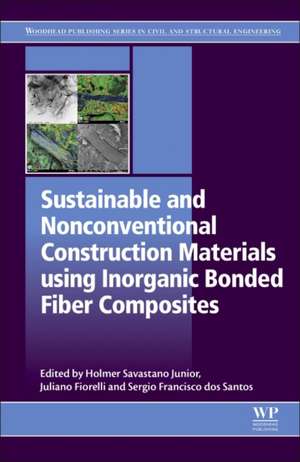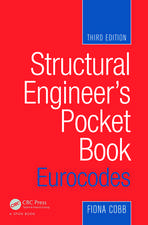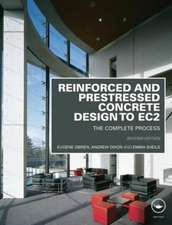Sustainable and Nonconventional Construction Materials using Inorganic Bonded Fiber Composites
Editat de Holmer Savastano Junior, Juliano Fiorelli, Sergio Francisco Dos Santosen Limba Engleză Hardback – 16 iun 2017
The book gives a comprehensive review of the innovative research associated with building components based on inorganic bonded composites. Exploring both natural fibers as reinforcing elements and alternative inorganic binders based on agricultural and industrial wastes, this book also considers the performance and applications of fibrous composites as construction materials and components.
- Dedicated to analyzing recent developments in inorganic fiber composites research
- Discusses the broader subjects of processing, characterization, performance, and applications of non-conventional construction materials
Preț: 1341.68 lei
Preț vechi: 1753.59 lei
-23% Nou
Puncte Express: 2013
Preț estimativ în valută:
256.72€ • 268.04$ • 212.48£
256.72€ • 268.04$ • 212.48£
Carte tipărită la comandă
Livrare economică 29 martie-12 aprilie
Preluare comenzi: 021 569.72.76
Specificații
ISBN-13: 9780081020012
ISBN-10: 0081020015
Pagini: 494
Dimensiuni: 152 x 229 mm
Greutate: 1.25 kg
Editura: ELSEVIER SCIENCE
ISBN-10: 0081020015
Pagini: 494
Dimensiuni: 152 x 229 mm
Greutate: 1.25 kg
Editura: ELSEVIER SCIENCE
Public țintă
R&D specialists in inorganic bonded fiber composites, researchers and engineers interested in non-conventional construction materials, civil and environmental engineering, and biosystems engineering and architectureCuprins
1. Lignocellulosic residues in cement-bonded panels
2. The effect of sodium hydroxide surface treatment on the tensile strength and elastic modulus of cellulose nanofiber
3. Interfacial transition zone between lignocellulosic fiber and matrix in cement-based composites
4. Treatments for viable utilization of vegetable fibers in inorganic-based composites
5. New inorganic binders containing ashes from agricultural wastes
6. New trends for nonconventional cement-based materials: industrial and agricultural waste
7. Alternative inorganic binders based on alkali-activated metallurgical slags
8. The potential use of geopolymer for cleaning air
9. Sustainability assessment of potentially ‘green’ concrete types using life cycle assessment
10. Hatschek process as a way to valorize agricultural wastes: effects on the process and product quality
11. A study of a hybrid binder based on alkali-activated ceramic tile wastes and portland cement
12. Accelerated carbonation as a fast curing technology for concrete blocks
13. Macro- and nanodimensional plant fiber reinforcements for cementitious composites
14. Using vegetable fiber nonwovens cement composites as sustainable materials for applications on ventilated facade systems
15. Potentialities of cement-based recycled materials reinforced with sisal fibers as a filler component of precast concrete slabs
16. Experimental investigations on cement-bonded rattan cane composites
17. Bi-component polyolefin fibers used for concrete and shotcrete applications
2. The effect of sodium hydroxide surface treatment on the tensile strength and elastic modulus of cellulose nanofiber
3. Interfacial transition zone between lignocellulosic fiber and matrix in cement-based composites
4. Treatments for viable utilization of vegetable fibers in inorganic-based composites
5. New inorganic binders containing ashes from agricultural wastes
6. New trends for nonconventional cement-based materials: industrial and agricultural waste
7. Alternative inorganic binders based on alkali-activated metallurgical slags
8. The potential use of geopolymer for cleaning air
9. Sustainability assessment of potentially ‘green’ concrete types using life cycle assessment
10. Hatschek process as a way to valorize agricultural wastes: effects on the process and product quality
11. A study of a hybrid binder based on alkali-activated ceramic tile wastes and portland cement
12. Accelerated carbonation as a fast curing technology for concrete blocks
13. Macro- and nanodimensional plant fiber reinforcements for cementitious composites
14. Using vegetable fiber nonwovens cement composites as sustainable materials for applications on ventilated facade systems
15. Potentialities of cement-based recycled materials reinforced with sisal fibers as a filler component of precast concrete slabs
16. Experimental investigations on cement-bonded rattan cane composites
17. Bi-component polyolefin fibers used for concrete and shotcrete applications








